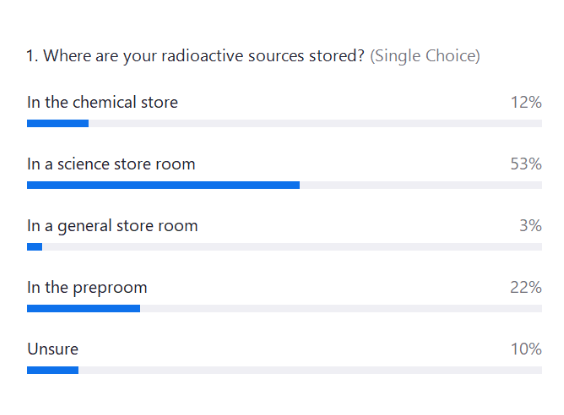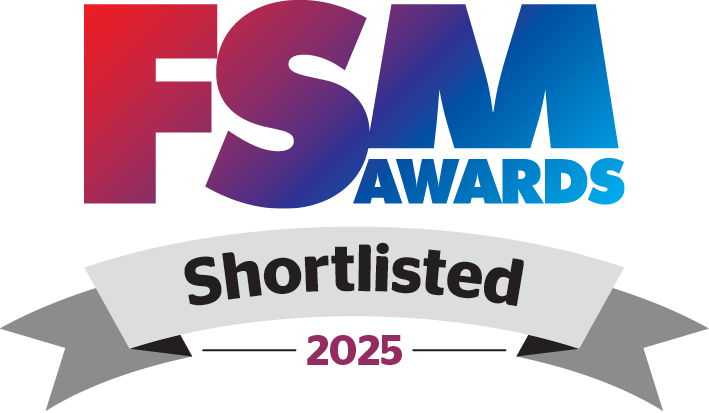The Ins and Outs of Keeping Radioactive Materials in your School
(1)_1000.png)
This blog is based on Judicium’s Health and Safety ‘Sofa Session’ from the 28th February, with our resident expert Jonathan Davies MSc CertIOSH. This session focused on: the law governing radioactive materials in science, the paperwork surrounding it, HSE inspections, on-site, and storage arrangements.
Poll 1
.png)
The Law Governing Radioactive Materials in Science
Judicium’s Sofa Session from 31st January on COSHH Beyond the Cleaning Cupboard and Science Department looked at how some substances are so dangerous they have their own regulations – radioactive materials are one of these.
The two we are focusing on are:- Ionisation Radiation Regulations 2017
- The overarching legislation about radioactive material.
- The Environmental Permitting (England and Wales) Regulations 2010
- Details how to appropriately dispose of materials safely.
These, along with a few others including the Health and Safety at Work Act, cover the legal basis for the need to manage radioactive sources within schools.
However, the main document is L93 from CLEAPSS. This document is free and outlines all procedures required to be in place for radioactive materials. NB: This was very recently updated over half term. We will mention some of the changes but please see G144 for an indication of all updates.
Paperwork
There are two main documents required:- A policy outlining the arrangements onsite including names of responsible persons
- A radiation folder/file.
The policy will generally be separate from your main H&S policy. It is science specific and you will most likely find it included in the general science policy. NB: Templates are available through CLEAPSS.
The radiation file/folder should be specific and contain several different documents, including:- Logbook – Indicates when a source is used, by who and when with signatures from the responsible person indicating processes have been followed.
- CLEAPSS document – L93 (recently updated 26/2/24). You no longer need GL016 as dosage rates are now included within the new version of L93.
- Within L93 are some templates for:
- Contingency plans (section 9)– these indicate what to do, in reference to the radioactive sources, in emergency events such as during a fire. There are segments here that need to be completed.
- Standard operating procedures (section 6.5). This outlines the normal procedures for using the sources. There are segments that need to be completed by the RPS.
- Risk assessments for each source (section 6.6.1). If you are using approved sources from CLEAPSS, you have risk assessments for them. Your responsible person must understand these assessments and ensure the controls are followed. The RPS will need to sign at the bottom of each risk assessment in the box available.
- Dosage rates – section 15 indicates the dosage rates which were originally contained within GL016. You must tick to indicate what sources you have.
- Records of tests
- Training records
- Includes both external, such as the radiation protection supervisor (RPS), and internal to your staff members including technicians.
- You should keep a record of what your in-house training covers. This must include contingency plans (section 9).
- Records of sources held
- Indicates what sources you have and information regarding them such as original activity, delivery date and supplier, radionuclide and unique name/reference number.
- Indicates what sources you have and information regarding them such as original activity, delivery date and supplier, radionuclide and unique name/reference number.
- Records of disposal.
- Any time you dispose of sources you must keep evidence that you have done so per the regulations.
- Any time you dispose of sources you must keep evidence that you have done so per the regulations.
- Records of notification and Form 1.
- Your radiation protection officer (RPO) will most likely request your Form 1s.
- Since 2018, the HSE requires each school to notify them that radioactive sources are held on-site through an online form. If you are unsure, notify your RPO.
Poll 2
.png)
Radiation arrangements
If you are using radioactive sources, you must have a trained radiation protection supervisor (RPS) onsite. This is the person who has responsibility for the radioactive materials onsite and who provides in-house training to others.
Overall, you need access to a radiation protection officer and advisor. NB: Some advisors function as officers as well.
The legal requirement is you have access to suitable H&S advice concerning radiation. This means access to a radiation protection advisor (RPA), with a radiation protection officer (RPO) acting to facilitate the paperwork side of arrangements whilst also completing audits for schools.
Training
Firstly, the RPS needs to have formal instructor-led training, which is refreshed every five years. Commonly, this will be the head of physics, HOD or responsible teacher with the lead science technician or physics technician as their second.
Top Tip: Always consider training multiple people. This will ensure you always have a trained RPS on site and minimises disruption if staff leave.
In-house training must cover all the procedures and controls indicated in the risk assessments (see L93) and must be given, face-to-face, by the RPS or someone who has completed RPS training.
NB: You must keep a log of what the training included, who completed the training and when. This in-house training should be refreshed annually or at least every two years.
Procedures
Using sources
- A safe working procedure should be in place. Templates are in L93 along with the risk assessments. This will include transporting sources to rooms and their use in classrooms, such as demonstrations or A-level practical work. Recommendation is that transportation occurs when there is no risk of students being in corridors.
- Every time you use a radioactive source it should be documented in the logbook. This should indicate which sources were used, the date and time it was taken from storage, who used it, whether a safety talk was given and what time it was returned to the store. Each of the steps should be signed by the responsible person. Students (over 16) must be given a safety talk when using the sources.
- Make sure you have suitable emergency procedures in place, especially in case of a fire. You can find an example in the standard operating procedures.
Tests and inspections
Radioactive sources, like most other things, require regular maintenance, tests, and inspections. Visual inspections must be done every month and a leak test annually.
Monthly inspection
- It’s a visual inspection confirming all the sources are present and in good condition.
- The purpose of this check is to ensure everything is secure and to identify any damage or degradation.
- During these inspections it is good practice to also test the Geiger muller tube is functioning.
- Always keep a record of these checks.
-
L93 has a new template for these checks so be sure to switch to the new version for your next one. The new requirement is to list each source separately.
Annual leak test
- It’s more in-depth and should be carried out by a trained person, such as the RPS.
- The purpose of this test is to identify if any sources have become damaged in a way that causes the radioactive material to “leak” from the container, which would contaminate surfaces.
- The procedures will have been discussed during training and can be found in the CLEAPSS L93 document.
-
As always, keep records of these tests. Templates are available within L93.
If a source fails, you must stop using it. It should be placed, still within its original container, in a strong plastic bag and labelled “do not use”. Further consultation with your RPA is then required (or CLEAPSS). The source should still be kept in the normal storage area in the meantime.
Poll 3

Storage
Schools may struggle with a lack of storage, even in newer buildings. Radioactive materials must be stored according to very specific guidelines and it’s the area we receive the most questions about.
Location of the store.- The sources themselves must not be situated within 2 metres of working areas, which could be a staff desk or even a washing up station.
- The distance includes in any direction and through walls, so you must also think about what is directly below the store, depending on where in the room they are located. Also, think about the rooms next to the store.
- The 2-metre rule applies to general staff workstations, but sources can be situated within 1 metre of a working station if it is used by different people throughout the day. For example, student desks in a classroom where different classes use the room each hour.
- It cannot be used as a general store and must only be used by science.
- Only authorised people should have access.
- It must be affixed to the wall. Very few people should have access to this key but would include the RPS and a spare held by the premises team/lead fire warden to provide to the fire and rescue services in an emergency.
- Each source should be kept in their original container.
NB: You must not store any flammable or oxidising substances in the same store as the radioactive sources and you must not store any gas cylinders here either.
Generally, it is not recommended to use signage on the external storeroom door as it advertises where the sources are kept. However, the lockable metal cabinet should be signposted. The premise team should be made aware of the location of sources, which they will include on a laminated building plan for the fire and rescue services.
If you do not have a separate storeroom available, you can store the sources in a lockable prep room where the same guidance applies.
Transporting the sources from the store to the labs.- It is recommended to have a lockable container to transport between areas within the school. However, you can also use procedural controls as outlined earlier to mitigate risks of theft or accidental losses and damage.
3 Key Takeaways
- What’s in place?
- Policy
- Radiation folder
- RPS, RPO and RPA
- Storage
- Training
- External and internal with a log of what is covered.
- Record all training.
- Processes
- Safe use procedures from being collected from the store, use in a classroom and returning to the store.
- Maintenance and testing.
Additional Info:
The Health and Safety Service is also providing accredited training courses, including eLearning with specific modules ranging from courses designed for premises managers and SLT to all staff offerings and fire warden training: https://www.judiciumeducation.co.uk/elearning
We also offer live, exclusive training options https://www.judiciumeducation.co.uk/training
To review Judicium’s forthcoming sofa sessions please click here.
Follow us on Twitter - @JudiciumEDU
© This content is the exclusive property of Judicium Education. The works are intended to provide an overview of the sofa session you attend and/or to be a learning aid to assist you and your school. However, any redistribution or reproduction of part or all of the contents in any form is prohibited. You may not, except with our express written permission, distribute or exploit the content. Failure to follow this guidance may result in Judicium either preventing you with access to our sessions and/or follow up content.
Related content
.png)
This blog is based on Judicium’s Health & Safety and SEND session on 26th November with resident expert India Cottenden
.png)
This blog is based on Judicium’s Food Safety Sofa session on 12th November with resident experts Sue Roberts and Tracey Killick

This blog is based on Judicium’s Health and Safety ‘Sofa Session’ on the 15th of October, with our resident expert Mike Wright.

This prestigious award celebrates our commitment to delivering expert, education-specific Health & Safety support that lifts the burden for school teams while raising safety standards across the sector.

This blog is based on Judicium’s Health and Safety ‘Sofa Session’ from 18th June, led by resident expert , Mike Wright, CMIOSH. This session focuses on the control of substances hazardous to health (COSHH) and their relevance in school settings, how assessments should be undertaken and what staff could be at risk.

Discover why Judicium has been shortlisted for Fire Safety Consultancy of the Year at the 2025 FSM Awards, recognising our expert support for schools and trusts in delivering sector-specific, compliant, and practical fire safety solutions.

Sofa Sessions | H&S